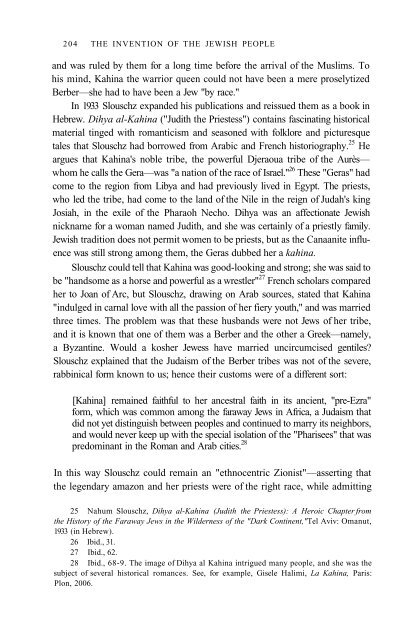Shlomo Sand, The Invention of the Jewish People - Rafapal
Shlomo Sand, The Invention of the Jewish People - Rafapal
Shlomo Sand, The Invention of the Jewish People - Rafapal
You also want an ePaper? Increase the reach of your titles
YUMPU automatically turns print PDFs into web optimized ePapers that Google loves.
204 THE INVENTION OF THE JEWISH PEOPLE<br />
and was ruled by <strong>the</strong>m for a long time before <strong>the</strong> arrival <strong>of</strong> <strong>the</strong> Muslims. To<br />
his mind, Kahina <strong>the</strong> warrior queen could not have been a mere proselytized<br />
Berber—she had to have been a Jew "by race."<br />
In 1933 Slouschz expanded his publications and reissued <strong>the</strong>m as a book in<br />
Hebrew. Dihya al-Kahina ("Judith <strong>the</strong> Priestess") contains fascinating historical<br />
material tinged with romanticism and seasoned with folklore and picturesque<br />
tales that Slouschz had borrowed from Arabic and French historiography. 25 He<br />
argues that Kahina's noble tribe, <strong>the</strong> powerful Djeraoua tribe <strong>of</strong> <strong>the</strong> Aurès—<br />
whom he calls <strong>the</strong> Gera—was "a nation <strong>of</strong> <strong>the</strong> race <strong>of</strong> Israel." 26 <strong>The</strong>se "Geras" had<br />
come to <strong>the</strong> region from Libya and had previously lived in Egypt. <strong>The</strong> priests,<br />
who led <strong>the</strong> tribe, had come to <strong>the</strong> land <strong>of</strong> <strong>the</strong> Nile in <strong>the</strong> reign <strong>of</strong> Judah's king<br />
Josiah, in <strong>the</strong> exile <strong>of</strong> <strong>the</strong> Pharaoh Necho. Dihya was an affectionate <strong>Jewish</strong><br />
nickname for a woman named Judith, and she was certainly <strong>of</strong> a priestly family.<br />
<strong>Jewish</strong> tradition does not permit women to be priests, but as <strong>the</strong> Canaanite influence<br />
was still strong among <strong>the</strong>m, <strong>the</strong> Geras dubbed her a kahina.<br />
Slouschz could tell that Kahina was good-looking and strong; she was said to<br />
be "handsome as a horse and powerful as a wrestler" 27 French scholars compared<br />
her to Joan <strong>of</strong> Arc, but Slouschz, drawing on Arab sources, stated that Kahina<br />
"indulged in carnal love with all <strong>the</strong> passion <strong>of</strong> her fiery youth," and was married<br />
three times. <strong>The</strong> problem was that <strong>the</strong>se husbands were not Jews <strong>of</strong> her tribe,<br />
and it is known that one <strong>of</strong> <strong>the</strong>m was a Berber and <strong>the</strong> o<strong>the</strong>r a Greek—namely,<br />
a Byzantine. Would a kosher Jewess have married uncircumcised gentiles?<br />
Slouschz explained that <strong>the</strong> Judaism <strong>of</strong> <strong>the</strong> Berber tribes was not <strong>of</strong> <strong>the</strong> severe,<br />
rabbinical form known to us; hence <strong>the</strong>ir customs were <strong>of</strong> a different sort:<br />
[Kahina] remained faithful to her ancestral faith in its ancient, "pre-Ezra"<br />
form, which was common among <strong>the</strong> faraway Jews in Africa, a Judaism that<br />
did not yet distinguish between peoples and continued to marry its neighbors,<br />
and would never keep up with <strong>the</strong> special isolation <strong>of</strong> <strong>the</strong> "Pharisees" that was<br />
predominant in <strong>the</strong> Roman and Arab cities. 28<br />
In this way Slouschz could remain an "ethnocentric Zionist"—asserting that<br />
<strong>the</strong> legendary amazon and her priests were <strong>of</strong> <strong>the</strong> right race, while admitting<br />
25 Nahum Slouschz, Dihya al-Kahina (Judith <strong>the</strong> Priestess): A Heroic Chapter from<br />
<strong>the</strong> History <strong>of</strong> <strong>the</strong> Faraway Jews in <strong>the</strong> Wilderness <strong>of</strong> <strong>the</strong> "Dark Continent,"Tel Aviv: Omanut,<br />
1933 (in Hebrew).<br />
26 Ibid., 31.<br />
27 Ibid., 62.<br />
28 Ibid., 68-9. <strong>The</strong> image <strong>of</strong> Dihya al Kahina intrigued many people, and she was <strong>the</strong><br />
subject <strong>of</strong> several historical romances. See, for example, Gisele Halimi, La Kahina, Paris:<br />
Plon, 2006.




